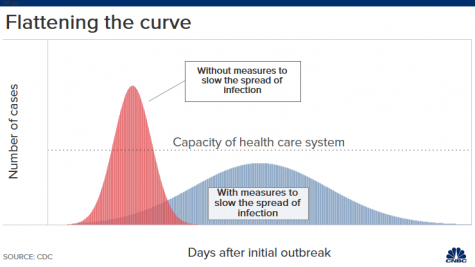Flattening the Curve

courtesy of The Boston Globe
April 10, 2020
As many news stations and media companies rush to inform the public regarding the COVID-19 outbreak, the term “flattening the curve” has become very common. Despite its popularity, however, many people are still confused as to what it even means.
The idea of a curve comes from epidemiology, where the “curve” refers to the estimated number of new cases over a period of time. A steep curve extends past the capacity of the current healthcare system. A gradual curve still reaches the same amount of people infected but does not overwhelm the healthcare system. The amount of time the virus is around is longer for a gradual curve, but it makes a pandemic much easier to contain and assess.

The faster the curve rises, the faster the health care system gets overloaded beyond its capacity to treat people. As we’re seeing in Italy, more and more new patients may be forced to go without ICU beds, and more and more hospitals may run out of the basic supplies they need.
WHO spokesperson Christian Lindmeier said, “We need to slow down the curve and slow down the spread and try to spread it over time as good as possible so that the health system can cope and production of vital medical equipment can cope.”
Charles Bergquist, director of the public radio science show Science Friday shared a metaphor for overloading the healthcare system: “Your workplace bathroom has only so many stalls. If everyone decides to go at the same time, there are problems. If the same number of people need to go to the restroom but spread over several hours, it’s all ok”.
This explains why so many schools and businesses have shut down or enforced working from home. If everyone stays inside and refrains from traveling, the chance of spreading the virus decreases.
One of the main ways that the COVID-19 curve can be flattened is by finding out ways to slow the rate of infection.
Scientists are working around the clock to find a vaccine for COVID-19, though the process will likely take longer than a year. Some countries, such as Italy, are forced to go into lock-down while other political leaders enforce “stay-at-home” orders. When we find ourselves in such a huge crisis, it can feel as if there’s nothing we can do to help.
The good news is there is always an opportunity to help “flatten the curve”. (And no, it doesn’t include buying an obnoxious amount of toilet paper).
Having to stay at home in isolation can affect mental health. Having no face-to-face conversations with peers makes staying inside even harder.
By staying in your home and only leaving if necessary, you are reducing not only the chance of you becoming sick, but also your family members and those who you are in close contact with. It’s more than just keeping your health protected.
When everyone does their part of following the guidance of local leaders and health officials, we all are helping to flatten the COVID-19 curve.











